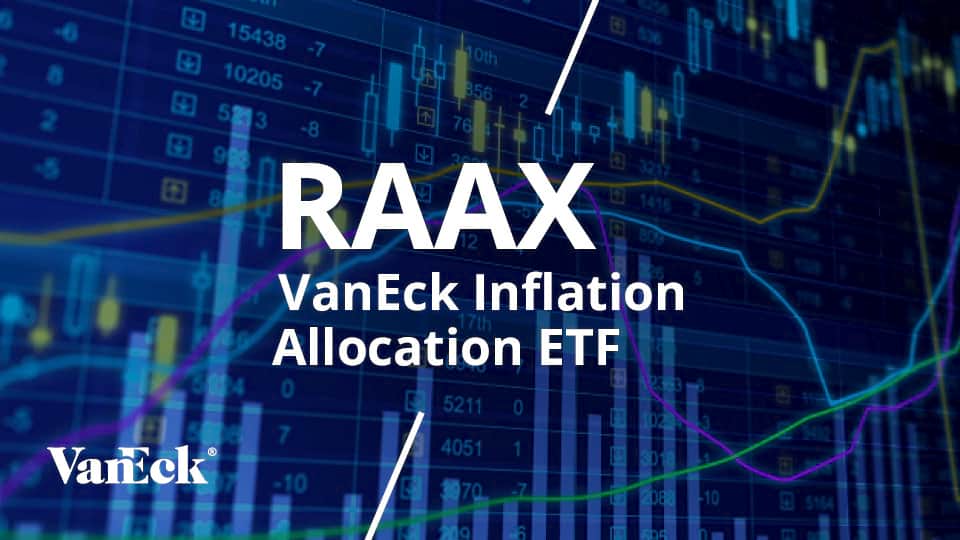Inflation Allocation ETF (RAAX): Question & Answer
14 September 2022
Read Time 6 MIN
Given that investors last faced inflation risk in the early-to-mid 2000s and not at this magnitude since the 1970s, few may have experienced the potentially destructive impact high inflation can inflict on a portfolio. In fact, investor allocations are likely reflective of a much different macroeconomic environment than exists today. Return expectations for both stocks and bonds, and the traditional role they play in a portfolio, may not continue going forward as inflation continues to linger.
Allocating to real assets is one way that investors can position their portfolios for a prolonged inflationary environment, as real assets have historically performed well in prior periods of high inflation. This blog is intended to answer frequently asked questions about real asset investing and more specifically, the VanEck Inflation Allocation ETF (RAAX®). RAAX seeks to be a one-stop, diversified and risk managed solution to access the inflation protection of real assets.
To get a better understanding of inflation and its impact on markets and portfolios, please view our latest insights, including blogs, videos, and webinars.
- What are real assets and how do they provide inflation protection in a portfolio?
- What asset classes does RAAX invest in?
- How does RAAX determine its exposures?
- Since RAAX invests in commodities, does it issue K-1s for tax reporting?
- How does RAAX select its underlying ETFs?
- How has RAAX performed in the current high inflationary period?
- Is Gold’s recent underperformance likely to continue?
- How does RAAX fit into a portfolio during weak growth and/or periods of lower inflation?
What are real assets and how do they provide inflation protection in a portfolio?
Real assets typically including commodities, natural resource equities, gold, MLPs, REITs and infrastructure. An allocation to real assets can serve three key roles in a portfolio:
- Hedge to inflationary pressure.
- Exposure to global growth.
- Portfolio diversifier.
Real assets have historically performed well in periods of high inflation, including during the 1970s and the last bout of inflation in the mid-2000s. Across both these periods, real assets, in general, outperformed traditional asset classes such as stocks and bonds.
Average 12M Real Return when CPI is at or Above Certain Levels (1969-1981)
Source: Bloomberg. "Comodities" = Bloomber Commodity Index; "Gold" = Gold spot price in U.S. dollars per troy ounce; "Equities" = S&P Index; "Fixed Income" = U.S. Generic Government 10-Year Treasury yield. Please see important disclosurs and index definitions at the end of presentation. Past performnace is not indicative of future results.
Average 12M Real Return when CPI is at or Above Certain Levels (2003-2007)
Source: Bloomberg. Past Performance is no guarantee of future results. Please see important disclaimers and index definitions in Disclosure.
What asset classes does RAAX invest in?
RAAX’s investable universe includes most of the individual asset classes commonly accepted as real assets. The Fund primarily allocates to exchange-traded products (“ETPs”) that provide exposure to inflation fighting real assets including resource assets: commodities, natural resource equities; income assets: REITs, Infrastructure, MLPs; and financial assets: gold and gold stocks.
RAAX’s three primary groups are based on the type of asset and the benefit it potentially offers investors.
How does RAAX determine its exposures?
To allocate to these real asset classes, RAAX utilizes a rules-based, quantitative investment process to determine allocations. This process is overseen by VanEck’s Multi-Asset Solutions (MAS) team and led by Portfolio Manager, David Schassler. The Team comprised of members with mathematics and computer science backgrounds acts as the firm’s internal resource for quantitative research and risk measurement.
Specific metrics related to each individual asset classes’ return and risk characteristics are analyzed. With these metrics as inputs, a quantitative optimization process is used as a guide to determine the asset class weightings. This quantitative approach allows the portfolio to dynamically adapt exposures to market conditions while providing diversification and a consistent risk profile over time. Portfolio exposures are monitored on a daily basis.
Since RAAX invests in commodities, does it issue K-1s for tax reporting?
Unlike some other strategies which provide access to commodities, RAAX is offered in a traditional, 40 act ETF structure. Accordingly, there is no K-1 tax reporting and investors will receive manageable 1099 forms at year end.
How does RAAX select its underlying ETFs?
Exposures, liquidity and costs are key criterion used to select the underlying ETFs. RAAX may use both external and internal, or those offered by VanEck, ETFs. Fees for underlying VanEck ETFs are waived and are not included in RAAX’s overall expense ratio.
How has RAAX performed in the current high inflationary period?
The rate of inflation has been rising and we expect that inflation will remain elevated for some time. In the current inflationary period, RAAX’s exposure to inflation-fighting real assets has responded and provided the expected inflation hedge within a portfolio.
Please visit VanEck Inflation Allocation ETF (RAAX®) for standardized performance as of the most recent month end.
VanEck Inflation Allocation ETF (Ticker: RAAX) Performance vs CPI YoY Change
Source: Bloomberg. As of 06/30/2022. RAAX NAV performance. Past performance is not a guarantee of future results.
Is Gold’s recent underperformance likely to continue?
Gold has lagged other real assets due, primarily, to the market’s general view that high inflation may not persist coupled with a strong U.S. dollar relative to other currencies.
The charts below splits the last two high inflationary regimes into halves. Historically, gold has outperformed in the second half of the inflation cycle. The inflection point is tied to changing investor psychology with the recognition that inflation has become a problem with detrimental impact on daily life.
1st Half of the 1970s High Inflation Regime
1st Half of the Mid-2000s High Inflation Regime
Source: Bloomberg. Past performance is not a guarantee of future results.
Source: Bloomberg. Please see important disclaimers and index definitions in Disclosure. Past performance is not a guarantee of future results.
2nd Half of the 1970s High Inflation Regime
2nd Half of the Mid-2000s High Inflation Regime
Source: Bloomberg. Please see important disclaimers and index definitions in Disclosure. Past performance is not a guarantee of future results.
How does RAAX fit into a portfolio during weak growth and/or periods of lower inflation?
During periods of high inflation, such as now, RAAX has the ability to favor real assets that benefit from inflation, such as commodities and natural resource equities. Alternatively, during periods of low inflation, RAAX has the ability to concentrate its holdings in real assets that have historically performed well in that environment, such as REITS and infrastructure.
More recently, concerns regarding a potential recession or stagflationary environment have become more prominent among investors. Historically, based on data from the 1970s, in periods when GDP declined and inflation remained elevated above normal levels, real assets still outperformed stocks.
Finally, real assets may also offer diversification benefits and exposure to global growth within a portfolio regardless of the level of inflation.
Average Quarterly Returns When GDP is Negative and CPI is Above Average
(September 1969 - September 1982)
Please see important disclaimers and index definitions in Disclosure.
index definitions
CPI – US CPI Urban Consumers YoY NSA Index measures US consumer prices (CPI) as a measure of prices paid by consumers for a market basket of consumer goods and services. The yearly (or monthly) growth rates represent the inflation rate.
Commodities – Bloomberg Commodity Index is made up of 23 exchange-traded futures on physical commodities, representing 21 commodities, which are weighted to account for economic significance and market liquidity.
Gold – Gold spot price in U.S. dollars per troy ounce.
Equities – S&P 500 Index is a free-float weighted measurement stock market index of 500 of the largest companies listed on stock exchanges in the United States. Prior to January 4, 1988 the index is Total Return, and after it is Price Return.
Fixed Income – U.S. Generic Government 10-Year Treasury yield assuming a constant 7 year duration to approximate a generic U.S. Government Treasury return.
Natural Resources – S&P Global Natural Resources Index includes 90 of the largest publicly-traded companies in natural resources and commodities businesses that meet specific investability requirements, offering investors diversified and investable equity exposure across 3 primary commodity-related sectors: agribusiness, energy, and metals & mining.
Infrastructure – S&P Global Infrastructure Index is designed to track 75 companies from around the world chosen to represent the listed infrastructure industry while maintaining liquidity and tradability. To create diversified exposure, the index includes three distinct infrastructure clusters: energy, transportation, and utilities.
REITS – Dow Jones Equity REIT Index is designed to measure all publicly traded real estate investment trusts in the Dow Jones U.S. stock universe classified as equity REITs according to the S&P Dow Jones Indices REIT Industry Classification Hierarchy. These companies are REITs that primarily own and operate income-producing real estate.

